Fraumünster Zürich, Switzerland
- Deborah Kade
- Apr 5, 2020
- 10 min read
The Fraumünster, in English: Women's Minster, but often wrongly translated to Our Lady Minster, is a church in Zurich which was built on the remains of a former abbey for aristocratic women which was founded in 853 by Louis the German for his daughters, Hildegard and Betha. He endowed the Benedictine convent with the lands of Zürich, Uri and the Albis forest, and granted the convent immunity, placing it under his direct authority. Today, it belongs to the Evangelical Reformed Church of the canton of Zurich and is one of the four main churches of Zurich, the others being the Grossmünster, Prediger and St. Peter’s churches.
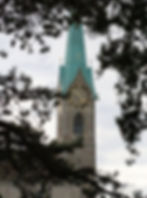
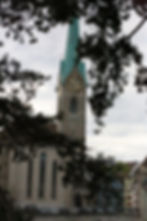
"For the around 500,000 visitors every year, a newly instituted visitor management system started in June 2016. From November 1st to February 29th the Fraumünster Church is open from 10am to 5pm and from March 1st to October 31st from 10am until 6pm. Guided tours are allowed only in a "whisper" mode, and by accredited tour guides. To accommodate the need for a peaceful atmosphere, as well as for safety and technical reasons, groups are limited to a maximum size of 60 participants.
The use of cameras, mobile phones, and computers is not permitted on church premises. Eating and drinking are prohibited; dogs and other animals must stay outside. Wardrobe should be appropriate for the visitation of an ecclesiastical building.
An admission/information fee of CHF/EUR/USD 5.00 applies for touristic-visitors. In return you receive free access to the crypt museum and visitor information in one of eight available languages – an audio guide or an illustrated brochure."
More and more churches in Europe are adopting similar practices. I remember the time when we could just walk in, pray and take pictures of the Marc Chagall stained glass windows. Photography is not allowed in the Fraumünster. They certainly enforce this rule now!! If you want a picture of the stained glass or the interior, there are postcards and books to purchase. Luckily, I took pictures before these new rules.
"In 1045, King Henry III granted the convent the right to hold markets, collect tolls, and mint coins, and thus effectively made the abbess the ruler of the city.
Emperor Frederick II granted the abbey imperial immediacy in 1218, thus making it totally independent of all authority save that of the Emperor himself, and increasing the political power of the abbess. Flourishing in the Middle Ages until the Swiss Reformation, Fraumünster had “imperial immediacy,” which gave the abbey a privileged political and constitutional status under imperial feudal law. The abbesses of Fraumünster were thus able to act and rule with tremendous power, independent of everyone except the HolyRoaman himself. The abbess assigned the mayor, and she frequently delegated the minting of coins to citizens of the city. However, the political power of the convent slowly waned in the fourteenth century, beginning with the establishment of the guild laws in 1336 by Rudolf Brun, who also became the first independent mayor, not assigned by the abbess.
The abbey was dissolved on November 30, 1524 in the course of the reformation of Huldrych Zwingli, supported by the last abbess, Katharina von Zimmern.
The monastery buildings were destroyed in 1898 to make room for the new Stadthaus, city hall. The church building today serves as the parish church for one of the city's 34 reformed parishes.
Münsterhof, historically the main square and marketplace of the medieval city, is named for the abbey. Gesellschaft zu Fraumünster cultivates the traditions of the former nunnery convent."
"Situated on the west bank of the Limmat River some 551 feet (180 meters) across from Grossmünster Cathedral, the Fraumünster Church was founded in 853 CE by Louis the German (r. 843-876 CE). According to legend, Louis’ two pious daughters, Princess Hildegard (828-856 CE) and Princess Bertha (d. 877 CE), used to live near by Zürich at Baldern Castle, and they frequently visited the city to worship before the relics of Saints Felix, Regula, and Exuperantius at Grossmünster Cathedral. One early morning, as the royal sisters made their daily visit to Grossmünster, they saw a white stag with burning antlers in the middle of the dark forest. The two women followed the stag, which took them to the edge of the Limmat River directly across from Grossmünster Cathedral. This encounter would repeat itself each morning until the sisters understood that God had given them a sign and had intended them to oversee a religious sanctuary for women at the edge of the river. King Louis was not entirely convinced by his daughters' stories until a rope fell from the heavens to mark the exact spot of where construction should commence. King Louis, Hildegard, and Betha thus oversaw the construction of Fraumünster Church, and the female duo became the first abbesses at the abbey."
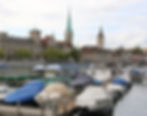

"In the Early and High Middle Ages, the abbesses of Fraumünster administered the convent where many noblewomen from southern Germany, Switzerland, and Austria took their religious vows. These abbesses, however, wielded immense power through the 14th century CE. From the 10th century CE onward, they enacted rules and procedures regarding the customs on goods entering Zürich, appointed city mayors, acted as judges in trials, organized trade, fairs, and minted their own coinage. From the 13th century CE, the abbess was even given the title of “imperial princess.” The incumbent abbess of Fraumünster was consequently the de facto ruler of the city of Zürich during most of the Middle Ages. Notable abbesses included Mechthild of Tyrol (r. 1145-1170 CE), Judith of Hagenbuch (1229-1254 CE), Mechthild of Wunnenberg (1255-1269 CE), and Elisabeth of Wetzikon (1270-1298 CE). It was only in the 14th century CE that Zürich’s guilds begin to regain political and economic privileges back from the Abbess of Fraumünster through the establishment of guild laws (“Zunftordnung” in German) at the command of Rudolf Brun (c. 1290-1360 CE), Zürich’s first independent mayor."


"Although Brun managed to limit the influence exercised in Zürich’s urban affairs by the abbesses of Fraumünster, the abbesses and Fraumünster Church remained quite influential until the 16th century CE. Zürich emerged as an important pilgrimage center during the high and late Middle Ages as the Catholic faithful visited the relics of St. Felix, St. Regula, and St. Exuperantius while en route to other pilgrimage centers like Santiago de Compostela in Spain, the Vatican in Rome, Italy, and the Benedictine Abbey in Einsiedeln, Switzerland, which lies only 25 miles (40 kilometers) to Zürich’s southeast. Although Fraumünster was engaged in a perpetual rivalry with neighboring Grossmünster for control over the relics of the city’s three patron saints, the two churches shared and publicly showcased these relics in an elaborate urban procession held annually on September 11th. (That day is the feast day of the three saints; this day is still celebrated as a holiday in the city of Zürich.) The two churches also grew incredibly wealthy through the offerings donated by pilgrims from across Europe.
In 1519 CE, Ulrich Zwingli (1484-1531 CE) arrived in Zürich to begin his new work as pastor at Grossmünster Cathedral. Though born into a family of farmers, Zwingli was an educated man who completed his studies at the University of Vienna and University of Basel. The ideas of the Dutch philosopher Erasmus (1466-1536 CE) strongly influenced Zwingli, who shared Erasmus' belief that scripture should be read and preached liberally in one’s native language as opposed to Latin. Zwingli quickly broke with established Catholic tradition soon after his arrival in Zürich, preaching a new, radical interpretation of the Gospels. Zwingli, with governmental approval and cooperation, dissolved Zürich's monasteries and confiscated the possessions belonging to Zürich's various churches and monasteries over the course of 1523-1524 CE."
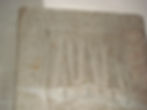

Curiously, Zwingli knew Fraumünster’s last abbess from childhood: Katharina von Zimmern (1478-1547 CE). She had been a wise abbess who was praised for her learning and skillful management of the abbey's finances. Von Zimmern (r. 1496-1524 CE) did not oppose Zwingli's Reformation and shrewdly passed control of Fraumünster to the city of Zürich in late 1524 CE. She would remain a key figure in Zürich’s political and social affairs until her death, but Fraumünster would become a Protestant church forever losing its former independent status. Like the other churches, abbeys, and monasteries in the Canton of Zürich, Fraumünster was physically affected by Zwingli’s reforming zeal. The current austere simplicity of Fraumünster’s interiors is a direct result of Zwingli’s Reformation. In 1524 and 1525 CE, reformers removed Fraumünster’s altars, organ, and all religious ornaments. Decorated walls and ceilings were whitewashed, and Fraumünster’s stained glass windows were removed. The church’s gable above the choir was removed as well, and Fraumünster’s roof was altered into the hipped roof that visitors can see today.

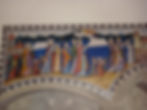

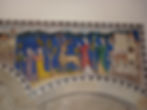
"Before the construction of Fraumünster, Celtic and Roman structures existed on the site now occupied by the church. Unlike nearby Grossmünster, Fraumünster has seen substantial changes in its design and structure since the first construction of the church in the 9th century CE. In comparison to Grossmünster Cathedral, Fraumünster reflects more of a hybridization of Romanesque and Gothic styles due to constant construction and remodeling over the centuries. During the 11th century CE, a large altar room with a choir apse was built, which provided Fraumünster with a traditional cross-shaped layout. The 9th-century CE crypt beneath the new choir was remodeled and a Romanesque cloister was built on the church’s southern side during the 12th century CE. Fraumünster was completely remodeled in stages during the 13th century CE, and the altar room was enlarged to its maximum extent. While important medieval structures have been kept in place - the Romanesque choir and the high vaulted transept - Fraumünster's south tower was entirely removed in the 18th century CE. Parts of the convent complex, including old residential buildings for the canonesses, were destroyed in 1898 CE. Conservationists renovated Fraumünster's nave in 1911 CE, strengthening the church's north tower as a result of the removal of the south tower over a century earlier.
Fraumünster is renowned for the modern art and other curiosities found within its doors. Several frescoes by the Swiss artist Paul Bodmer (1886-1983 CE) illustrate the legend of the founding of Fraumünster by Princesses Hildegard and Bertha, as well as portraits of Zürich’s patron saints Felix and Regula. August Giacometti (1887-1947 CE) - uncle to the equally famous Swiss artist Alberto Giacometti (1901-1966 CE) - designed the stained glass window in Fraumünster’s north transept in 1945 CE. Marc Chagall (1887-1985 CE) worked at Fraumünster too, and he designed five stained glass windows in the 1970s CE in addition to Fraumünster’s beautiful rosette, which is located in the church’s south transept. Fraumünster’s organ with 5,793 pipes is the largest in existence in the Canton of Zürich."

Note that the organ pipes are in the shape of angel wings. You will find this in many church pipe organs.

People mostly visit the Fraumünster to see the Chagall windows. Equally impressive is the 9 meter tall stained glass of the North transept, created by Augusto Giacometti in 1940.
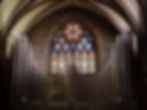
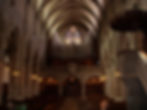
In the 1960's , Zurich city officials searched for a suitable artist to create beautiful stained-glass windows for their historical and important church. Despite an extensive international search, the city did not find a suitable or worthy artist for the job.
In 1967, Zurich hosted a large Chagall exhibition in one of their major art museums. Many of his paintings in this exhibition were of whimsical images and figures symbolizing tolerance, love, peace and faith. The exhibition impressed the Fraumunster pastor so much, that he decided to offer the Belarussian-born Chagall the commission of the stained-glass windows.
Chagall was 80 years old at the time but at the height of his artistic career. It is said that Chagall sat inside the church and felt so inspired that he decided to take on the massive project. Indeed it astonished everyone when 80 year old Chagall accepted this huge commission.
Marc Chagall led a secular life in his adult years. However as a child, Chagall grew up in a very religious Jewish family in Russia. As expected of all Jewish boys, he studied in a religious primary school that focused on biblical studies.
"It is therefore not surprising that Chagall, although not a practicing Jew, was knowledgeable and felt comfortable around religious themes. In fact, many of his paintings throughout his entire artistic life included religious elements. Chagall’s religious background remained imprinted within his soul and he expressed it through his art.
Marc Chagall created a five-part stained-glass window series and a rosette for the chancel of the church. This world-famous masterpiece by Chagall still impresses visitors from around the world today. Marc Chagall remained true to his motto “When I create something from my heart, almost everything goes well”. He enjoyed excellent health right up to his death in 1985, just before his 98th birthday.
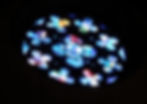
Chagall’s idea was to create windows in the choir zone behind the altar. He felt that this spacious open area would allow the worshipers to fully enjoy the views and the religious and humanist message of the windows.
"Chagall’s unique painting style is often characterized by simplistic figures and elements. He also painted with bright colors and fragmented-like Cubism. This style worked well also for designing a stained glass. Chagall’s idea for these windows was to incorporate both Jewish and Christian symbolism so that the subject matter is meaningful for the viewer of any faith.
For over three years, Chagall put his heart and soul into this project. He sketched the design of each window from his home in Saint Paul de Vence, on the French Riviera. Once finalized, he worked in close collaboration with a glass making factory in Reims.
After the colored glass panes were finished, Chagall outlined the figures and elements in black. They were then baked onto the glass. Marc Chagall spent many weeks in Zurich supervising and directing the installation."
The windows are best seen in the bright morning light as all five stained-glass windows illuminate the entire church. Those familiar with Chagall’s paintings, will recognize his colors immediately.
The deep and vibrant colors of Chagall’s windows are the first thing that you will notice.
The choir of the abbey includes 5 large stained glass windows designed by artist Marc Chagall and installed in 1970. Each of the 5 has a dominant color and depicts a Biblical story. From left (northern wall) to right, the 5 works are:
Prophets, depicting Elijah's ascent to heaven
Jacob, displaying his combat, and dreams of heaven
Christ, illustrating various scenes of Christ's life
Zion, showing an angel trumpeting the end of the world
Law, with Moses looking down upon the suffering of his people
On the north wall is the window of Prophets in orange and red. This window depicts Elijah’s soaring upwards into heaven on a chariot and a wretched Jeremiah, the bearer of news.
The window on the south wall represents the story of Moses and the ten commandments. This window is made in deep & bright hues of blue."
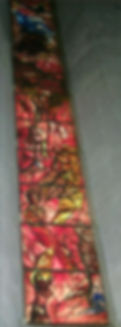

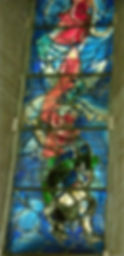
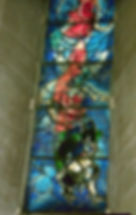
Three stained-glass windows occupy the eastern wall of the church. One window represents Jacob on his ladder wrestling with an Angel. Another window depicts The End of Days showing an angel blowing a trumpet. The third window, the “celebrity” of them all, is the green “Christ” window. It is the longest of all the stained glass windows.
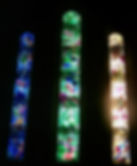

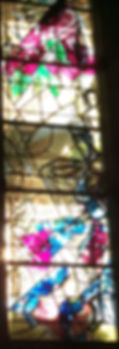







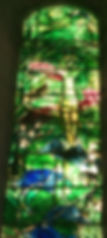

"The windows offer the viewer many interpretations.
Some say that the tall, long and narrow windows represent the vertical connection between the earth below and the heavens above.
Others say that Chagall’s use of blue and green represent earth’s main elements (water and nature) and red and yellow symbolizing the heavenly glow.
It is generally agreed that the vast amount of images in the windows symbolize the complexity of God’s creation of the universe."
